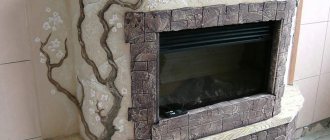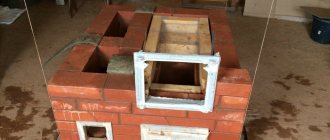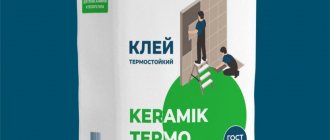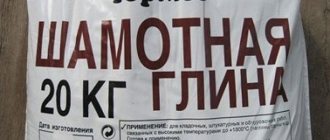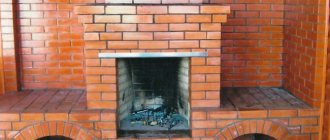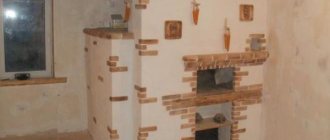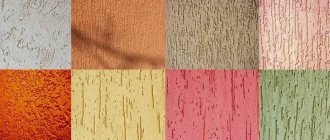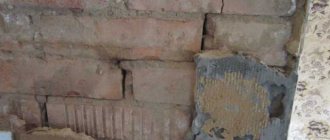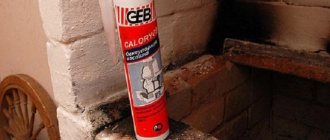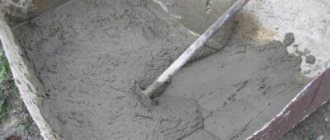Why plaster the sauna stove and fireplace?
Bricks, clay mortar or iron are used to make the stove. Fireplaces are made from brick, stone blocks or concrete mortar.
The structures can withstand temperature changes; finishing is necessary for long-term and safe operation. A popular way to decorate stoves is plastering. Finishing mixtures are selected in accordance with the required thermal conductivity and base material.
Plastering a heating device is necessary to solve the following problems:
- strengthening stoves and fireplaces;
- improving the tightness of the structure;
- preventing cracking of brickwork;
- design for an updated interior;
- increasing aesthetics;
- leveling the stove or fireplace base;
- plastering the fireplace will prevent the appearance of insects and fungus in the seams of the blocks;
- increasing the heat capacity of the furnace;
- treatment with a fire-resistant mixture increases the level of safety in the room.
Stove plaster has the following advantages in finishing:
- simple application, which is performed without complex equipment;
- the material is universal, can be used for different surfaces (concrete, brick);
- after the leveling layer, decorative mixtures with the effect of a marble surface or Venetian plaster can be applied to the box;
- the product can be used for restoration work to restore the fireplace;
- after plastering, it is possible to paint the surfaces or whitewash the base;
- the composition is more economical than other finishing methods.
How to plaster a stove or fireplace so that the coating does not crack
Applying plaster is a prerequisite for high-quality furnace work.
It is necessary to plaster the heating device to ensure:
- additional tightness - this reduces the leakage of carbon monoxide into the bathhouse or house;
- increased thermal insulation;
- improvement of appearance;
- leveling and strengthening the masonry;
- base for decorative coating.
The plaster mixture is used for finishing more often than porcelain stoneware and stone.
The advantages of plaster include:
- efficiency;
- accessibility and ease of application;
- versatility;
- possibility of restoration;
- it increases the heat capacity of the stove wall;
- After drying, it is painted or whitened.
When heating the heating device, there is a temperature difference reaching 300-400°. Cracking occurs due to a mismatch between the expansion parameters of bricks and finishing. This is possible if the technology for applying the solution is violated or if it is prepared incorrectly. Ready-made mixtures, which are sold in construction stores or traditional ones based on clay and sand, allow you to plaster the surface in compliance with the rules. When cured, they do not form shrinkage cracks.
Plaster for stoves has the following characteristics:
- fire resistance;
- elasticity;
- heat resistance;
- environmental friendliness.
Important! Solutions prepared independently must meet all requirements.
A new furnace requires shrinkage for 3 months. During this time, it must be heated several times in order for the masonry to finally harden. After that, the seams are cleaned with a metal brush, and notches are applied to the concrete with a chisel. Oil stains are degreased. To increase the adhesion of plaster, use a primer for stoves and fireplaces.
If the stove unit requires repairs, then you need to tap the old coating, remove loose pieces, as well as paint and whitewash. The surface of the walls is carefully swept.
Reinforcement increases the strength of the coating. In addition to asbestos, slag wool and fiberglass are added to the solution. Additionally, a mesh made of steel and fiberglass with a small mesh size is attached to the wall using special nails; or burlap soaked in a liquid mixture.
Classification of plaster for stoves and fireplaces in the house and requirements for it
Before finishing the structure, a suitable material is selected. There are 2 types of mixtures used in the work: simple and complex.
The plaster mixture must meet the general requirements:
- resistance to temperature changes, high heat-resistant performance;
- the structure of the material ensures easy application to the base and prevents the composition from shedding after drying;
- the components of the finishing mixture must be environmentally friendly and safe after heating;
- the composition must be fire-resistant, not subject to fire and maintain performance characteristics when heated regularly;
- Crack resistance and good adhesion are required.
Simple formulations
Simple mixtures consist of 2 components (clay and sand). Before preparing the solution, the sand is passed through a sieve, and the clay is ground through a fine-mesh metal mesh. After pre-processing, the raw materials are cleared of impurities and debris.
The clay needs to be soaked in water for 2-3 hours to increase the plasticity of the mass and prevent cracks from appearing on the treated surface. To increase adhesion, experts recommend using fatty types of clay for solutions. In this case, the ratio of clay and river sand should change.
Complex mixtures for ovens
Plastering of stoves is also done using complex mixtures. Solutions may contain more than 2 components. Products are produced that contain more than 3 ingredients.
The following complex options for plaster mixtures are in demand:
- from lime, river sand and clay;
- with asbestos, sand and clay mass;
- from clay, asbestos, cement powder and sand;
- a multicomponent solution may contain clay, fiberglass, gypsum powder, lime and sand.
For complex mixtures, it is important to choose the right ratio of water and dry mass to prepare a coating that is aesthetically pleasing and resistant to mechanical stress.
Plaster solutions
Today you have the opportunity to choose between buying a ready-made dry mixture for plastering the stove or preparing the solution yourself according to proven “folk” recipes. To achieve a high-quality result, it is necessary to carefully observe the ratio of dry components and water, which must be either tap water or technical water (neither lake nor river water can be used for the solution).
Depending on the purpose of the room and its humidity, the mode of its use, the planned method of exterior finishing, as well as the climate in the region, the owner must decide how to plaster his stove.
How to prepare the “correct” solution? The classic recipe includes clay and sand. If you plan to paint the stove white, then lime can be added - it must be slaked. To increase the strength of the solution, you can add crushed asbestos or fiberglass.
The composition of the mortar for plastering the stove may vary. The table shows the main popular options:
| Clay | Gypsum | Sand | Cement | Lime | Asbestos | Fiberglass | |
| ratio of parts in solution | |||||||
| 1 | 1 | — | 2 | — | — | 0,1 | — |
| 2 | 1 | — | 2 | — | 1 | 0,1 | — |
| 3 | — | 1 | 1 | — | 2 | 0,2 | — |
| 4 | 1 | — | 2 | 1 | — | 0,1 | — |
| 5 | — | 1 | 1 | — | 2 | — | 0,2 |
The sand content in the solution may vary depending on the fat content of the clay that will be used. If the fat content is high, then instead of two parts of sand, it is permissible to add three or even four.
To determine the correct ratio, you need to prepare a portion of the sample solution and apply it to the surface - a small area. If, after the solution has dried, the plastered area becomes covered with cracks, this means there is not enough sand and more needs to be added. If the solution crumbles, this indicates that there is not enough clay in its composition.
Bad solution
Types of plaster
It is possible to determine what is used to plaster the stove, taking into account the technical characteristics of the varieties.
The following compositions are in demand:
- clay-sand;
- cement-clay-sand;
- gypsum based;
- lime-clay-sand;
- with asbestos, etc.
Clay sand
Simple clay-sand plaster is characterized by plasticity, waste-free use, and fire resistance. Clay mortar is economical. Clay can be purchased or prepared yourself. When digging up material, it is necessary to clear the mass of grass, rhizomes, stones and sift it using a sieve. The composition is the optimal plaster for a brick oven.
The advantages of a solution with sand and clay are as follows:
- low thermal conductivity ensures long-term heat retention in the oven;
- the composition is environmentally friendly and safe to use;
- good vapor permeability;
- long shelf life of the material, even in diluted form the composition will not deteriorate for a long time;
- the hardening speed is average, it is possible to make adjustments during design;
- plaster is suitable for coating the stove;
- clay-sand coating is repairable;
- the material is waste-free to use.
However, it must be taken into account that the thickness of the coating must be at least 1 cm to prevent cracking and shedding. The standard solution proportions are 1 part clay to 2 parts river sand.
Cement-clay-sand
Heat-resistant plaster for stove structures is a complex mixture and consists of cement, clay and sand. The product is durable and is used for finishing fireplaces and structures in bathhouses. However, it is necessary to take into account the rapid drying speed of the solution. The mass is prepared in small portions and quickly applied to the surface.
The solution is prepared from 3 parts sand, 1 part clay and cement. If the plastered surface is facing externally with tiles, it is necessary to add 1 part each of chalk and liquid glass to the composition to increase the strength of the base and resistance to cracking.
Calcareous-clay-sandy
Fireproof plaster for finishing stove structures is made from clay, lime (1 part each) and water (2 parts). Adding lime components to the mixture increases the plasticity, strength of the material, adhesion, disinfects the mass, and prevents the appearance of insects and mold.
Gypsum based
A plaster solution based on gypsum in combination with lime is characterized by plasticity and good adhesion. The material is kneaded in small portions, because the mixture hardens quickly (15-20 minutes after application to the base).
Fireproof plaster with asbestos added
Heat-resistant plaster for stoves and fireplaces containing asbestos is characterized by high strength and good adhesion to the surface. Asbestos acts as a reinforcing component in the finishing mixture. When mixing on your own, add the substance in small portions.
Plaster with asbestos has the following advantages:
- durability of the coating;
- moisture resistance of the base;
- non-flammability;
- preventing the formation of cracks.
Strengthen the plaster mixture with salt
The mortar for plastering the stove can be strengthened with salt to increase the hygroscopicity of the clay base. The coating does not dry out, retains its plasticity and will not crack. Salt increases the protective characteristics of surfaces, prevents the formation of mold and damage to the base by insects when treating a stove in a country house or country house.
The addition of salt slows down the drying of the mixture and allows you to adjust the quality of the coating. Gypsum powder can be included in the solution to increase the strength of the composition.
However, it must be taken into account that the plaster mixture with the addition of gypsum dries faster, so it is diluted in small portions.
Advantages of plastering the stove
Without decoration, the walls of the stove do not look aesthetically pleasing, since building bricks are used for masonry without the use of neat facing bricks. Such heating structures are always finished with finishing materials. Here are a few reasons why the use of plaster is important:
- The fine-grained mortar fills the pores in the masonry mixture. This prevents carbon dioxide from entering the room.
- The leveling mixture can be used as a stand-alone coating or as a base for any heat-resistant facing material.
- Plaster is acceptable for finishing any stove or fireplace. This could be restoration, strengthening or decoration. At the same time, the universal mixture can be considered an economically advantageous choice due to its relatively low cost.
In addition, this material, to one degree or another, has insulating properties, which helps to retain the heat of the furnace walls for a longer time. The solution is easy to work with and dries quickly. You can give the oven surface a smooth, rough or decorative texture.
Decorative plaster on the stove Source www.elitfasad.rf
We plaster a brick oven with our own hands - step-by-step instructions
Many people are interested in how to plaster a stove with their own hands.
It is recommended to follow the following steps:
- cleaning, eliminating cracks with heat-resistant putty and leveling the surface;
- preparation of solution;
- base reinforcement;
- applying the plaster mixture.
Necessary tools for plastering a brick oven
The following tools are required:
- Master OK;
- trowel;
- spatulas;
- grater or grater
- ironing board;
- metal brushes;
- hammers;
- scissors for working with metal;
- plumb line, building level;
- construction mixer;
- rule;
- brushes;
- beacons, etc.
Do-it-yourself oven surface preparation
Before plastering the stove, you need to prepare the base. Irregularities on wall panels are leveled with a special solution. If there are large defects, it is recommended to install beacons. In places of deformation, the mixture is applied in layers. After plastering is completed, the beacons and planks are removed from the base.
The remaining grooves are filled with solution. When using planks, the soil layer can be more than 10-15 mm. The coating is smoothed using the rule. The corner parts are leveled with a special spatula. When preparing the base for tiling, 2 layers of mortar will be sufficient before applying plaster with the addition of fireclay clay.
Basic rules for preparing the mixture: composition, proportions (how to prepare the solution)
Before plastering the base of the stove, you need to mix the finishing compound.
Before work you need to prepare materials:
- The clay is soaked 24 hours before use. Then the mass is filled with water, debris is removed from the clay, and the liquid is drained. The remaining material is mixed until smooth.
- River sand is used as an additional component, which must be washed, sifted, and dried. Wet material is not used.
- Asbestos needs to be fluffed up.
- Lime dough or milk is prepared from lime.
When finishing different types of surfaces (bricks, stone blocks), a solution of components in different proportions is used. As standard, dry substances are mixed, then liquid mixtures are added. For stoves fired with peat briquettes or coal, fireclay powder must be added to the composition.
You can prepare a solution from the following components:
- clay (1 part);
- asbestos (0.1 part);
- sand (2 parts);
- lime dough (1 part);
- water (until the required consistency is achieved).
The ingredients are mixed until smooth.
For another version of the solution, substances will be required in the proportion 1: 2: 0.1: 1, respectively:
- clay;
- river sand;
- asbestos;
- cement grade from 300 and more.
First, sand and clay are combined. The mixture is diluted with water, then the remaining components are added.
How to properly reinforce ovens with mesh
Before plastering the stove, you can perform mesh reinforcement. The method allows you to strengthen the plaster coating, prevent peeling of the material and the appearance of cracks.
The following components are added to the reinforcing mixture (optional):
- asbestos fiber;
- slag wool;
- fiberglass;
- hemp, etc.
The greatest strength is ensured by the use of metal mesh. Fastening reinforcement for stoves with uneven walls with a layer of plaster coating greater than 1.5 cm is mandatory. The work is carried out using nails 10-11 cm long. The elements are placed at intervals of 2-3 rows of bricks. The horizontal step is 15 cm. The mesh can be fixed using wire in the brickwork. Choose metal threads from copper and stainless steel.
Applying plaster to a brick stove
You can plaster the stove yourself using a spatula.
The work is performed in the following sequence:
- The oven is heated in advance.
- Two types of solution are prepared (liquid, creamy consistency and dense with high viscosity).
- The quality of the reinforcement layer is checked. If there are any unevenness, the chips are covered with fire-resistant putty.
- The bricks need to be wetted with water.
- Plastering is carried out with a liquid solution in a layer of no more than 5 mm, the work is carried out with a wash brush.
- The coating is left to dry, then a viscous plaster solution is mixed.
- The mass is evenly distributed over the base of the oven using movements from top to bottom.
- After the mixture has hardened, you can grout.
- When drying the plaster, the treated base is moistened with water to prevent areas from delaminating.
Technology for plastering a stove
To carry out work on plastering a stove, a set of tools for a mason and a painter is required. You will need a hammer and chisel to work with the base. For the solution, use a container for mixing, spatulas, trowels, graters with smoothers. For alignment, a rule and a level are used.
Additionally, a construction knife, brushes with a roller, and a brush with metal bristles may be useful. The list of consumables looks like this: mixture, water, soil, beacon and corner-forming profile, reinforcing fiber or plaster mesh, gloves, whisk attachment for a drill or hammer drill for preparing the solution. It is also necessary to provide protection for adjacent walls and floors from contamination. For this you will need film and masking tape.
Preparatory work
In the case of a new stove, it is permissible to begin finishing work only after several thorough heatings over a period of 2-3 months. Then shrinkage of the structure, which leads to cracking of the plaster coating, will be eliminated. For older units this requirement is not relevant.
New stove for finishing Source yandex.net
Next, before plastering the stove, you need to carry out preparatory work. The working base is considered to be a clean, grease-free and flat surface. Protruding excess masonry mixture or previous decorative finishing must be removed. Damaged bricks are restored or replaced completely. The depth of the seams must be at least 10 mm. Notches are applied to a durable concrete surface.
Frequently occurring defects and their prevention
Over time, during use, deformations and cracks may appear on the surface.
The reasons for the occurrence of irregularities are as follows:
- improper operation of the structure (overheating of areas);
- regular excess of temperature;
- door loosening;
- incorrectly performed plastering.
Depending on the cause of the deformation and the condition of the heating device, a method for eliminating the defects is selected. It is possible to reposition the stove, apply another layer of fire-resistant plaster, or add fireclay powder to the clay. The structure can be strengthened using reinforcing mesh.
Work on sealing the stove is carried out in compliance with the following sequence of actions:
- Surfaces are cleaned of whitewash.
- The primer layer is applied with a brush.
- Then the plaster mixture is prepared.
- The composition is applied to a pre-moistened area. Spread the mixture in small portions and rub the surfaces.
- The coating is dried.
- Doors and latches are removed, damaged areas are repaired.
- Then the elements are placed on the stove using updated fasteners.
- The work is completed by applying clay mortar to the stove surfaces.
Preparation
Ready-made mixtures must be diluted with water according to the proportion specified in the instructions for use. Sometimes special solutions are used for this. This is the most convenient option, however, the cost of such compositions, unlike homemade mixtures, is much higher.
To prepare, you will need a container and a mixer. First prepare the required amount of liquid, and then gradually add the mixture. The amount of water is indicated on the packaging, but it should be remembered that if the ambient humidity is high, the amount of water should be less than in hot weather. The liquid consistency is thoroughly mixed until a homogeneous paste is formed. Then the solution is infused for an hour and stirred again.
To prepare the solution with your own hands, you will need to purchase all the necessary ingredients, then mix them in the required proportion. This method is much cheaper. The advantages include the opportunity to use environmentally friendly products. However, difficulties may arise with finding the right components, as well as with preparing the right proportion.
Kiln masonry involves the use of different compositions depending on the type of surface. When forming a foundation that is underground, cement compositions are suitable. To form the side walls of the firebox, where the greatest impact of high temperature occurs, you need to use a refractory clay mortar. The mixture should be prepared every day, cleaning the components from dust, dirt and foreign particles.
To prepare a cement mortar, you will need cement powder, sand and water. The ratio of powder to sand is selected depending on where the composition will be used. The mixture is added to water, stirring thoroughly until a homogeneous mass is obtained. For stirring, use special devices, such as a trowel or mixer. In some cases, crushed stone is added to increase strength.
The clay-sand mixture is prepared by mixing clay with sand. The proportion is selected depending on the purpose, as well as the initial properties of the clay. Before mixing the components, the clay is thoroughly cleaned and sifted.
If the clay has medium fat content, then the approximate proportion can be 4: 2 - 4 liters of clean clay are poured into a pre-prepared container, then 2 liters of sand. The components are mixed, then water is added in small portions, thoroughly stirring the mixture. The result should be a homogeneous paste, the consistency of sour cream.
To prepare the lime mixture you will need lime, sand and water. The proportion is chosen depending on the purpose of the solution. Before preparing the mixture, the lime is thoroughly cleaned and sifted. First, mix the dry ingredients, then gradually add water, stirring the composition.
Cement-lime mortar is prepared from cement, lime, sand and water. The proportion is selected depending on the purpose of the mixture. Dry ingredients are mixed. Then water is gradually added, thoroughly stirring the solution.
Cement-gypsum mortar is prepared on the basis of lime, gypsum, sand and water. Before work, the lime is cleaned and sifted. The ratio of components is chosen depending on the purpose of the solution. First mix the dry ingredients, then add water in small portions. In this case, the composition is thoroughly mixed, bringing it to the desired consistency.
Lime-clay mortar is prepared using lime, clay, sand and water. Before work, it is necessary to carry out work to clean and sift lime and clay. The ratio of dry components is selected depending on the purpose of the solution. First, mix the dry ingredients, then slowly add liquid in small portions. At the same time, stir the pulp thoroughly, bringing it to a homogeneous mass.
Cement-clay mortar is prepared from cement, clay, sand and water. Before starting to prepare the mixture, the clay is thoroughly cleaned and sifted. The approximate ratio of dry components is 1: 4: 12, where one part of cement is mixed with four parts of clay and twelve parts of sand. Then slowly add water in small portions, mixing thoroughly, and bring to the desired consistency.
To prepare fireclay masonry mortar, which has increased strength, you will need Portland cement M400, sand, crushed stone and fireclay sand. The approximate ratio is 1: 2: 2: 0.3, where one part of cement is mixed with two parts of ordinary sand, two parts of crushed stone and 0.3 part of fireclay sand. Then add water and stir slowly until a homogeneous consistency is obtained.
How and what to grout the stove after plastering
The procedure for grouting the stove structure is carried out after the solution has hardened, which should not dry completely. The work is performed with a wooden or plastic grater, supplemented with a cloth attachment. The tool performs circular movements with adjustment of the degree of pressure. Surfaces must be regularly moistened with water. The result should be a smooth surface.
Advantages and disadvantages
Heat-resistant putty does not emit substances harmful to health when heated.
Heat-resistant putties have advantages over traditional solutions. They are characterized by high strength when exposed to high temperatures due to the presence of binding fibers and the use of refractory materials.
Positive aspects of use:
- The solution consists of safe components; when the surface is heated, harmful air impurities are not released.
- Putty prepared in compliance with the technology and application rules lasts a long time.
- The mixtures adhere well to the surface of the stove made of various materials; there are varieties that are used for finishing metal.
Disadvantages include higher cost than standard ready-mixes. Such compositions are rarely used as a finishing layer - they need to be painted or tiled.
Features of repairing fire-resistant stove plaster when cracks appear
If plastering work is carried out incorrectly, cracks may appear on the surface of the stove, the finishing layer may move away from the base, etc.
When deciding how to plaster the stove so that it does not crack, it is recommended to take into account the following nuances:
- Finishing of a new heating device is allowed only 2 months after laying. During this period, the structure will shrink.
- The installed stove must be heated so that the condensation in the chimney and on the walls evaporates. The duration of the procedure is gradually increased.
- It is recommended to plaster the surface with compounds with the correct proportions for the material of the fireplace or stove. For oily clay, sand consumption increases.
- Sanding can be done even on a damp surface; the work is done with a piece of fabric.
- The plaster layer dries in 3 days. After this, you can heat the stove structure.
- It is not recommended to prime a hot surface (with a temperature of more than +300°C), because Failure to comply with the requirements may result in foundation defects.
Expert advice on repairs
The stages of finishing the stove wall are identical for any selected mass. The differences are insignificant, but they are taken into account during the plastering process.
So the composition with the introduction of gypsum will dry 2 times faster than with cement. The use of fireclay clay in bulk is well suited for laying on bricks of the same composition, since the thermal conductivity is the same.
The plastered structure must dry without using auxiliary means.
More than one master will not answer how best to finish a stove building. Each stove maker has his own secrets and components of solutions for plastering brick surfaces. You can knead a clay and sand mixture and buy a ready-made mass. It is important to correctly connect and apply the material to the walls of the heated structure.
Ways to decorate sauna stoves and fireplaces
After plastering the stove is completed, decorative finishing is performed.
Available types of work:
- painting or whitewashing surfaces;
- applying decorative plaster mixture;
- facing with ceramic tiles.
How to paint a stove after plastering
After plastering, surfaces can be painted or whitened. Substrates must be primed before painting. The work is performed using brushes.
When using ready-made paints, experts recommend using water-based products and synthetic materials. The compositions must be heat-resistant.
When used to paint fireplaces, oil paints will quickly darken because... are not resistant to elevated temperatures.
The traditional way of finishing stoves and fireplace installations is whitewashing. A recommended method for plastering with a solution containing lime. Processing is performed in several layers. For every 10 liters of whitewash solution, 100 g of salt is used. You can give a bluish tint to the mixture by adding a small amount of blue to the composition.
Tile laying
Stove structures and fireplaces are lined with terracotta or ceramic tiles. The elements are fixed to a special adhesive base designed for treating surfaces that can withstand heat. Standard glue is not recommended for use, because... the lining will quickly fall off.
Tiles are not suitable for finishing stoves, because... will not withstand temperature increases. Tiles can be used to adjust the corner parts of structures.
The gluing of tiles is carried out in compliance with horizontal and vertical levels. The uniformity of spaces between elements is taken into account. The color scheme and texture of the tiles are chosen to suit the stylistic design of the rooms or country house.
Decorative plaster
Manufacturers produce specialized decorative plaster for fireplaces and stove devices. The material must have high thermal and wear resistance and strength. When using standard decorative plaster mixtures, gauze fabric can be used as an additional layer.
Decorative plasters with acrylic, silicate, silicone, mineral, and heat-resistant bases are recommended for finishing stoves. The mixture, ready-made or diluted in water, is applied using spatulas. The dried coating is treated with varnish or special wax.
About materials and tools
You need to learn how to plaster a brick stove and prepare all the necessary tools and materials in advance. You will need a set of tools, including:
- trowel or trowel;
- grater;
- hammer;
- chisel or spatula;
- wire cutters and pliers (they can be replaced with pliers);
- sprayer - it is needed to wet the surface with water (if you don’t have it, a paint brush will do);
- metal scissors and fabric scissors;
- coarse sieve - for sifting sand and / or clay;
- container for solution and separate for water;
- scoop for the plaster mixture (or its components);
- broom or vacuum cleaner.
The list of materials for plastering the stove includes the mortar itself for plastering the stove, a reinforcing mesh with 10 x 10 mm cells (you can get by with burlap), lime (or water-based paint), as well as a cement mortar (it will be needed to secure the wire, including case if we are talking about an old stove).
Reinforcing mesh with cells 10 x 10 mm
Popular brands of plaster mixtures
The most popular plaster compositions for the construction of stoves and fireplace installations are the following brands:
- PC400 W oven;
- Typhoon Master;
- Kalina Master;
- Terracotta;
- Stove maker, etc.
Heat-resistant ready-made plaster (thermal plaster) for stoves and fireplaces
When purchasing heat-resistant plaster compositions, it is important to consider the following nuances:
- established limit of operating temperature conditions;
- environmental friendliness of ingredients;
- hardening time;
- moisture resistance;
- resistance to sudden temperature changes;
- purpose of mixtures (for interior or exterior decoration);
- integrity of packaging, production date, etc.
PC400 W oven
The heat-resistant plaster material Osnovit PECHFORM PC400 W is used to treat areas near the hob, side walls of the fireplace, and stove. Permissible operating temperature is up to +400°C. After treatment with the mixture, no additional puttying of the base is required. When using shaped spatulas and rollers, you can make a relief base. The material is universal and is intended for interior and exterior decoration.
The composition is used to treat surfaces made of the following materials:
- concrete;
- composite slabs;
- limestone;
- bricks.
The mixture has an adhesion level of 0.5 MPa, the maximum fraction size is 0.315 mm. The frost resistance of the plaster is 35 cycles of freezing and thawing. The thickness of 1 application layer is 2-15 mm, mass consumption for a 10 mm layer is 12-13 kg per 1 m². Compressive strength reaches 5 MPa.
The mass is applied at a temperature in the range of +5…+35°C. The diluted solution is suitable for application within 2 hours. Coloring is allowed after 2 weeks.
Typhoon Master
The heat-resistant plaster mixture is produced by a domestic enterprise and is used for finishing chimneys, barbecues, and barbecue structures made of brick. The material is based on fireclay clay. The composition is universal and is used for interior and exterior decoration. The mixture is heat-resistant, withstands high humidity, plastic, and easy to apply. Material is consumed at the rate of 1.6-1.8 kg per 1 m².
Kalina Master
Fireproof plaster material is characterized by high strength, because... contains Portland cement. The coating can withstand changes in temperature conditions, surface heating, and is resistant to mechanical damage. When applied, the solution hardens quickly and has good adhesion properties.
Pechnik
Heat-resistant plaster for stoves and fireplaces of the Pechnik brand contains fireproof fireclay clay, cement powder, gypsum, and modifying polymer additives. The material is used for laying stoves and finishing them, repairing old structures, and hardens quickly. The mixture is easy to apply, does not deform when the device shrinks, can withstand heat, and the fire resistance parameter reaches 6000.
Heat-resistant adhesives
To fix tiles when finishing stoves, it is recommended to use adhesive bases with heat-resistant characteristics. Materials must have good adhesion, withstand high humidity and mechanical damage. Heat-resistant adhesives and mastics are produced by Pechnik, Hercules, etc.
Terracotta
Reinforced heat-resistant adhesive is used in finishing stoves, barbecue areas, baths and other heated surfaces with natural stone. ceramic tiles or facing bricks. The material contains kaolin fireclay dust, chemical additives, and astringent components.
The adhesive base has high adhesion characteristics to the surface, withstands heating up to +400°C, and is resistant to high air humidity. The glue is used for finishing surfaces made of aerated concrete blocks and fireclay bricks. The optimal layer thickness is up to 8 mm; the composition can be adjusted within 15 minutes.
Dry powder is diluted with water in a ratio of 1 kg per 260 ml. The material can also be used for leveling chips and adjusting brickwork. The optimal application thickness is up to 1 cm.
Mixture for plastering the Hercules stove
The composition is heat-resistant, used for finishing furnace structures and devices that heat up. The mixture is optimal as an adhesive base for fixing decorative ceramic tiles. The manufacturer offers the material in packages of 5-25 kg. The coating can withstand temperatures ranging from -50...+1200 °C. The adhesive is used for fixing low-porosity tiles and glazed tiles with increased bending strength.
Ready mixes
Plaster can withstand high temperatures for a long time, does not crack or crumble.
The building materials market is filled with various types of fire-resistant products that allow you to plaster stoves yourself. The most popular, well-deservedly recognized, are the heat-resistant compositions “Fireproof”, “Terracotta”, “Pechnik”.
“Fireproof” mixture, available in three modifications:
- smooth plaster;
- simulated mixture;
- composition for tiled surfaces.
When using a modeled variety, it is possible to obtain a textured surface onto which any pattern can be easily applied. The smooth composition is ideal for painting most stoves.
“Terracotta” is another dry mixture, which includes clay and fine fireclay sand with fireproof additives. The solution is intended for treating surfaces made of ceramic and fireclay bricks and can withstand heating temperatures up to 200 ºC.
The composition called “Kilnmaker” includes lime and sand, as well as gypsum, cement, asbestos and clay.
Manufacturers of heat-resistant plaster
Ready-made plaster compositions with heat-resistant characteristics are easy to use.
These products are offered by the following companies:
- "Concord East"
- Plitonit;
- Wolfshoher;
- "Bossnab";
- "Terracotta";
- Vetonit;
- Rath, etc.
Plitonit
The Plitonit company is a German-Russian production facility that produces a range of materials for laying fireplaces and stoves.
In the product line:
- heat-resistant plaster mixtures;
- adhesive bases with heat-resistant characteristics;
- heat-resistant putty;
- compositions with reinforcing components for the construction of fireboxes;
- decorative fire-resistant plasters.
SuperKaminOgneUpor plaster dries within 30 minutes after application. The coating does not crack, is resistant to high humidity, and does not collapse when the structure shrinks. There is no need to wet the brickwork before applying the mixture. The products include modifying additives and fibers with heat-resistant characteristics.
Concord East
The company has been operating on the market since 2000 and produces a range of building materials and paint and varnish products, including those with fire-resistant characteristics.
The company's assortment includes:
- primers:
- water-based, latex and acrylic-based dyes:
- adhesive compositions for different operating conditions:
- ready-made putties:
- oven plasters, etc.
Wolfshoher
The Wolfshoher company (Germany) has official representative offices in Russia. The factory produces stove bricks and materials for finishing stove and fireplace structures. The product line includes adhesive heat-resistant bases, mastics, plasters, putties and primers for ovens.
The materials are high-quality, durable, tested, and presented for different operating conditions. The production is developing improved products for fixing modern finishing materials.
Bossnab
(Russia) produces specialized products for furnace production. The line includes plaster compositions for finishing fireplaces and stoves made of different materials. The range has been supplemented with adhesive bases and primers. Plaster materials are produced in different fractions and differ in operating temperature conditions.
Terracotta
The domestic company produces products for plastering and fixing facing tiles. The product line includes thermally stable mixtures that can withstand heating up to +1300 °C. The products are environmentally friendly, because... contains only natural ingredients. The main raw materials used are kaolin, fireclay powder, sand, and binders. The list of products includes terracotta fireproof putty.
Rath
The RATH company (Austria) has representative offices in European countries and supplies products to the Russian market. The company's product line includes finishing materials with fire-resistant characteristics, oven plaster, putty, and adhesive bases. The products are high quality, durable, tested, but are very expensive.
Process Features
So, when you have decided on the choice of plaster, and the necessary tools are already at the ready, all that remains is to start creating. However, in order to properly plaster the stove, you need to follow a certain technology and sequence of processing steps.
Surface preparation
Preparatory work is an important process that ensures the quality and durability of plastering. So that all your work does not turn out to be in vain, first of all, you need to perform the following actions:
- Remove old layers of cladding using a hammer and chisel, and then clean the surface of dirt and remaining substances with a brush.
- If the stove is new, you should also clean the masonry.
- Deepen all seams by 0.5–1 cm and remove dust from them.
- Prime the walls, including the seams.
It is very important not to start cladding a structure if it has just been built. You need to wait at least 3 months for the stove to “settle” and for the materials from which it consists to adapt to operating conditions
Preparing the mixture
The solution must be prepared after all the preparatory measures have been completed, otherwise the plaster may harden and become unusable.
Before mixing all the ingredients, the sand must be sifted and cleaned of foreign impurities. The same applies to clay - it is crushed and all debris in the form of particles of rocks and plants is removed. Next, the clay is soaked in water until the liquid covers it by 10–15 cm. On average, this process takes 2–3 days. When the base is ready, it is combined with the remaining components and stirred with a mixer. In some cases, it is permissible to add water, since the consistency of the finished solution should be similar to sour cream.
Warp finishing
Sometimes old age, damage or unscrupulous work of builders can cause distortions in the walls of the stove. You can fix this this way:
- focusing on the building level, set up beacons for alignment;
- heat the stove so that it is warm;
- moisten the slanting wall with a roller or brush;
- the surface is primed and left to dry;
- the first layer of plaster is applied using the “spray” method so that the mixture covers all the seams;
- after the first layer has dried, apply the second - it should protrude about 1 cm above the beacons. Start work from the bottom, leveling the rule every half meter of the layer;
- the wet solution is polished with grout;
- To level the corners, use a special corner spatula.
Application of mesh
The use of this mesh in cladding allows not only to level and hide surface defects, but also makes the plaster coating more uniform and durable. To plaster the stove, you need:
- install the mesh near the work surface at a distance of no more than 2.5 cm;
- “spray” apply the plaster and wait for it to harden;
- cover everything with the next leveling layer;
- rub out;
- decorate.
Light plaster
The need for such work usually arises if the stove has no obvious defects or distortions, but needs cosmetic repairs. Plaster it like this:
- guide elements are fixed on a previously prepared surface so that the coating is uniform;
- apply the solution from bottom to top with a wide spatula, which is immediately leveled using the rule;
- the corners of the structure are plastered with an angle spatula;
- the result is neatly erased.
Covering
The last layer of plaster is necessary in order to completely level the surface of the stove. The primer needs to be moistened quite generously before applying it. The solution in this case should be used even less thick than for the first two layers. The mixture should fill absolutely all cracks and irregularities remaining on the surface. The thickness of the covering layer can be from 2 to 5 mm. It is impossible to level the stove in planes with plaster. Ultimately, the total thickness of the finishing layer should be no more than 1-1.5 cm. When laying out brick stoves for your home with your own hands, this should be kept in mind. When performing this work, you should initially try to make the walls as even as possible.
Fiberglass mesh for plaster as additional reinforcement
In order for the mortar to remain on the stove as firmly as possible in the future, it is not enough to use reinforcing additives in the form of straw or tow. When finishing, you should also use a special fiberglass mesh. This material can be purchased today in almost any construction supermarket.
Fiberglass plaster mesh is very inexpensive - about 30 rubles per 1 m2. When used on a stove, the finish lasts much longer. Instead of fiberglass, you can use metal mesh to reinforce the solution.
For plastering heating stoves, heat-resistant solutions based on clay, sand, asbestos and gypsum are used. You can prepare a wear-resistant mortar for plastering the stove using one of the following recipes:
- Mixing components: 1 part clay, 2 parts sand, 1 part lime paste and 1/10 part asbestos. Everything is thoroughly mixed with the gradual addition of water to obtain a viscous solution.
- Mixing components: 1 part clay, 2 parts sand and ½ part water. 1 part of cement (M 300, 400) and 1/10 part of asbestos are added to the resulting mass. All components are thoroughly mixed again, and if necessary, some water is added to obtain a thick, creamy solution. They can be used to plaster surfaces within 60 minutes after preparation.
- Combination of components: 2 parts lime paste and 1 part sand. Next, 1 part of gypsum, 1 part of water and 2/10 parts of asbestos are added to the resulting mass. Everything is thoroughly mixed until a viscous solution is obtained. Ready-made oven plaster is used to treat the surface for the first 15 minutes.
- Composition of components: 1 part clay, 2 parts sand and 1/10 part asbestos. Water is added to the resulting mixture to obtain a thick solution.
How to properly plaster corners
To make the stove look neat, carefully leveling the surface of the plaster is not enough. In addition, you will need to decorate the corners beautifully. To make them as neat as possible, it is worth using leveling slats. After the solution has dried, they should simply be removed. Instead of slats, you can also take an aluminum profile designed for attaching drywall. It is fixed to the stove using mortar and plastered flush. Of course, both the slats and the profile should be set using a building level.
Video description
Plastering a brick oven with your own hands.
Special oven glue is not diluted in large quantities as it tends to harden quickly. After this, it cannot be used a second time, since repeated dilution will cause the composition to lose its strong qualities.
Using special oven glue to seal joints between brick joints in a home oven Source waysi.ru
How to seal cracks in a metal stove
You may also need to decide how to cover the cracks in a metal stove, because it gradually burns out, and it is not always easy to allocate funds for repairs. Clay grout can be used as a restoration product. It is important to make a thick enough layer that will prevent combustion products from escaping from the firebox. The clay should be diluted in the traditional way, you can add a small amount of ash from the same oven and mix thoroughly until smooth.
Repairing a metal furnace by welding exfoliated metal fragments Source ipk-rotor.ru
If a hole or crack in the metal appears in the area where the chimney meets the stove chamber itself, then you need to take a small plate of metal, coat it with stove glue and fasten it to the deformed area. Seal the space on top with the same composition. To solve this issue, a reinforcing mesh is also used, which is subsequently plastered.
Preparatory activities
Before you start plastering the stove itself, its surface should be thoroughly cleaned. Under no circumstances should the solution be applied to smoked or dusty bricks. Otherwise, he won’t last long in the future. After cleaning, the stove should be heated. But there is no need to put too much firewood or coal into the firebox. Plaster for stoves and fireplaces is applied only to a warm surface.
It is impossible to finish the stove immediately after finishing its laying. You need to wait at least two weeks. The masonry must be thoroughly hardened before plastering.
Before you start applying the mortar, among other things, you should select 10 mm seams between the bricks. In this case, the heat-resistant mixture for plastering stoves will adhere to the surface better. You also need to drive small nails into the masonry, onto which the reinforcing mesh will subsequently be stretched.
